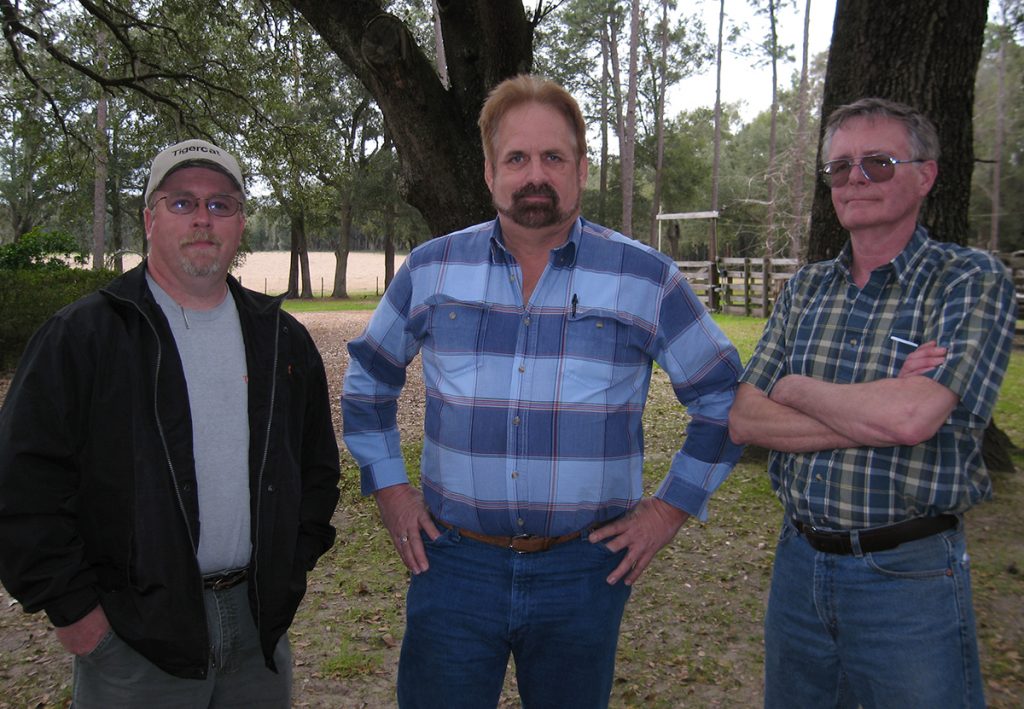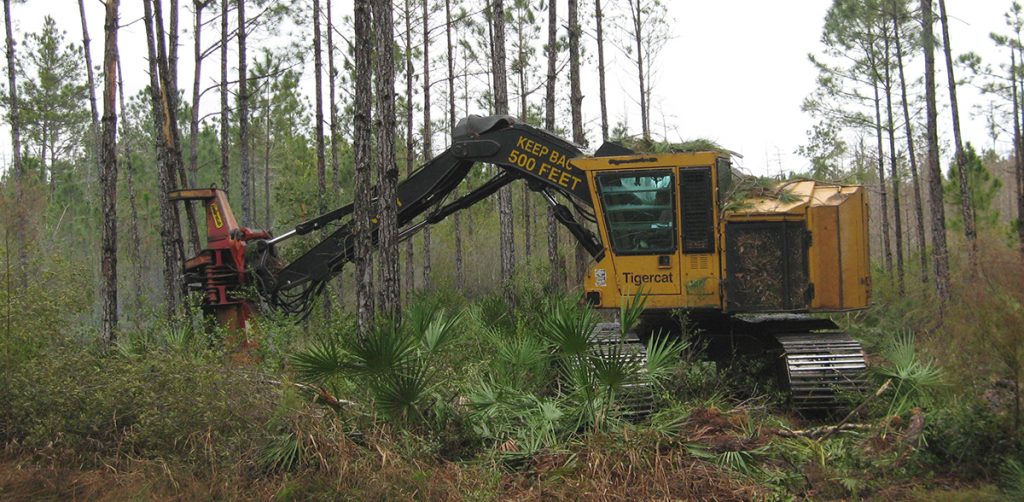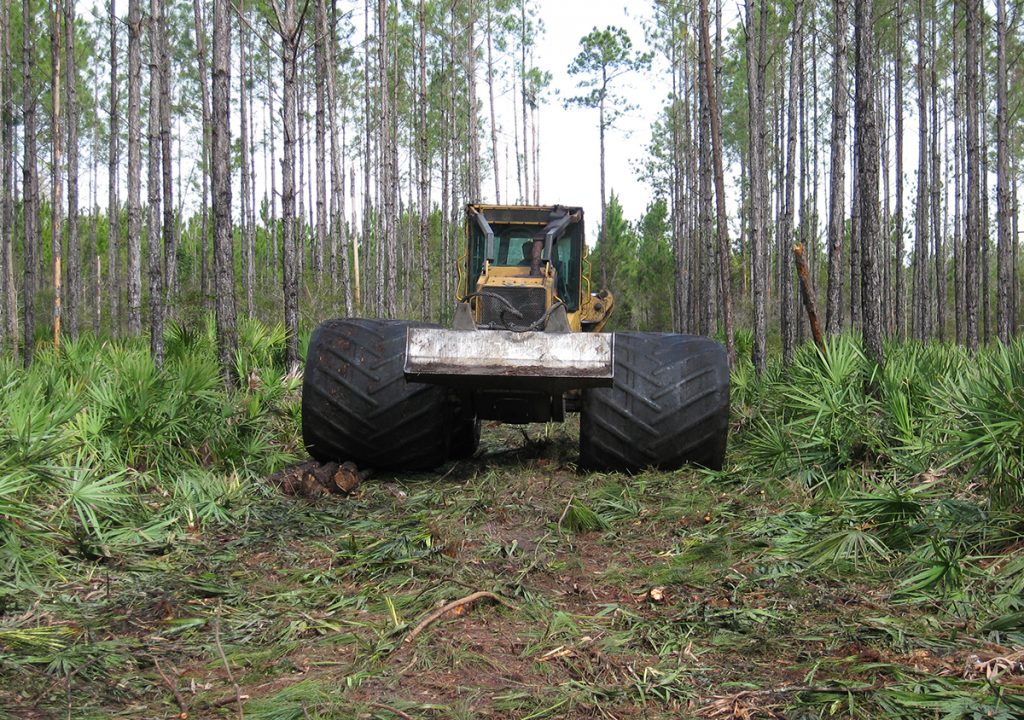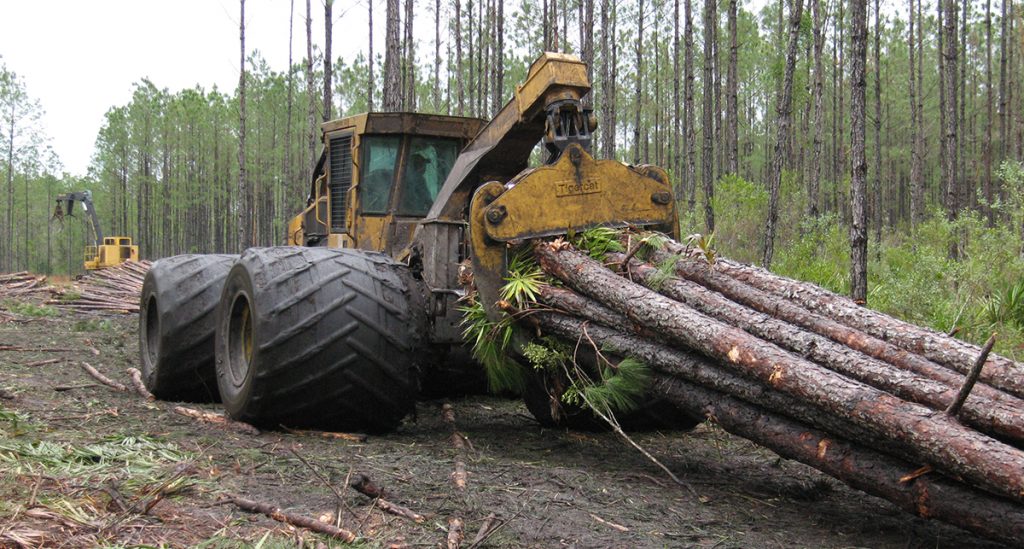6th March 2006
Successful businessman and unconventional thinker, Eddie Hodge talks about Williston Timber’s new low impact thinning concept and why, once upon a time, he and his brothers bought an unproven one-off machine from a bunch of Canadians.
— Paul Iarocci
Pulled off beside a north Florida highway in 1992 was a Mack truck hauling a strange looking feller buncher. Two guys stood armed and ready with a punch and die set and a ball-peen hammer: a truck driver called Don Snively and a tradesman named Jim Wood. Both worked for MacDonald Steel, a fabricating plant in Cambridge, Ontario.

Tigercat district manager Don Snively with Eddie Hodge, owner of Williston Timber and veteran MacDonald Steel employee Jim Wood who built the prototype 726 feller buncher.
Serial numbers and paper work were minor details that no one thought about during the rush to get the prototype Tigercat 726 feller buncher designed and built, that is until the prospect of jail loomed.
When it came time to build the prototype Tigercat 726 in 1992, Wood was the obvious choice. As a licensed electrician, millwright and automotive mechanic, he had the skills and talent to deal with the vagaries, complications and uncertainties that were sure to accompany the assembly of a new machine in the back corner of a steel fabrication plant. (Wood subsequently trained Tim Koniuch, Curt Martin, Stewart Maurer, Ross MacDonald and Denton Rerrie as the build schedule increased from one to 30 per year.) Tigercat was also lucky to hire assembler Larry Almond who had extensive technical experience with construction and forestry machines.
The clock was ticking and Wood recalls being questioned by Tigercat president Tony Iarocci regarding the machine’s state of readiness. “We can ship it now or wait three more weeks. Tony said ‘ship it tomorrow.’ We had the batteries bungee corded into the belly pan.”
Snively loaded the machine and climbed into the old Mack truck bound for Expo Southeast in Tifton, Georgia and Wood followed in a pick-up truck. They worked on the machine at rest stops in the evening. By the time they reached Georgia, it was acceptably finished. After the show the two of them, often accompanied by Iarocci and company owner, Ken MacDonald toured the southeast with the machine.
In 1992 Williston Timber was a big Deere customer. Recalling the Expo Southeast show and the Deere representatives who brought them, Williston co-owner Eddie Hodge says, “They were rushing us through the show to get us to the new Deere machines and we wanted to stop and look at this new Tigercat. The damn engine was turned around the wrong way… Besides it was a catchy name.”
Shortly after the show the Eddie and his operator flew to Louisiana where the machine was being demonstrated and met up with Iarocci, MacDonald, Snively and Wood. There were not many trees left on the site but they made due. “We cut some stumps and drove it around on some hills and found a few standing trees,” explains Eddie. Then he proposed the one-month trial.
Eddie recalls, “I said to Tony, ‘If you want to you can bring that thing to Florida. We don’t know anything about it, so you’ll have to leave the mechanic with it. If it stays together for a month, we’ll buy it.’ So that was the deal. It didn’t even have a serial number on it. Don gets stopped by the Florida DOT [Department of Transportation.] They’re calling us. He calls Canada and he’s down for like half a day. You know stolen equipment moves like that, you grind the serial numbers off… They’re from Canada. They don’t have any paper work. They’ve got a day cab truck. And all they wanted was to get rid of that thing and go home.” By the time Snively dropped the machine to the Hodges and headed for home, he had been away 40 days.

The operator can reach to the second row and remove trees without disturbing the stand or the ground.
Based in Williston Florida, Eddie, Johnny and Billy Hodge worked hard for twenty-five years building Williston Timber to where it is today. They played to each other’s strengths. Eddie was the businessman. Johnny, a self-taught mechanical engineer and inventor of specialized forestry equipment. Of the youngest brother, Eddie says, “Billy is on the ground, getting things done.” Together the three brothers kept operations running smoothly. Tragically, Johnny was killed in an accident. “Tragedy struck us hard on October the 5th, 2003, when we lost Johnny in a horrible truck accident.” Eddie says. “We lost more than a brother, a loved one and best friend. Our loss of Johnny struck to the very heart and soul of this business as well.”
For the record, the serial number started off as 726001 and kept Snively and Wood from further brushes with the law. To head off any potential questions the finance company might have with purchasing a prototype, the serial number was subsequently changes to 7260101, “Like we’ve got 101 of them,” jokes Eddie. “When that 101 tractor came, you would have thought the county fair came to town. Every damn logger in central Florida came. Some saw it at the show but by word of mouth it spread pretty quick. They’d be out there watching it and they’d want to get up close.”

Even at 15 ft – 10 in the 620 skidder can operate effectively in the thinning corridors.
“I remember that well,” Wood cuts in. “On Sunday I’d be out there checking on the oil and greasing it and there would be ten guys to come out and look at it… on a Sunday.”
As part of the deal, Wood stayed with the machine. “Jim’s got the most boring job in the world,” recalls Eddie. The machine ran day after day without incident “He sat in the service truck with no AC for three weeks. The tractor never stopped working. He’s still here on the weekend and he doesn’t have anything to do. This goes on for three weeks and we haven’t had a problem. He hadn’t been home in two months. I talked to Don and Tony and told them that he’s got to go home.”
That was the beginning of a relationship that has lasted fourteen years. Williston Timber purchased the first model 720 feller buncher and the second 845 track feller buncher. They’ve owned at least seventeen Tigercats over the years, piling ten of thousands of hours on them.
Regardless of how well the machine worked in the first month, the purchase was a big risk for Williston Timber. At the time, Tigercat had no dealer network. Parts were to be ordered directly from Canada. Eddie and Johnny had no idea if a second machine would ever be built.
But all this circumstance was somehow reassuring to the brothers. “Tigercat was always going to come out with something opposite. Same as us. If someone tells us an idea won’t work, we know we are on the right track,” Eddie explains. Also the Hodge brothers liked that fact that Tigercat was a small upstart. To them, the new company brought its own unique advantages. The top people were accessible, hands-on and always listening to the end user. Eddie marvels at the fact that Ken MacDonald once flew parts to him in his own plane and that Iarocci regularly checked in on them and brought drawings for the new 720 thinning feller buncher for their comments and input.
Butch Garvin who ran the 101 tractor recollects, “That machine cut 36 loads a day in the first year. We changed one o-ring and no hoses.” Eddie explains that to achieve that production, the machine would cut 30 loads in the daytime and an additional six in the evening.

The 620 runs 70 in rubber to prevent soil disturbance even after heavy rain.
Then he runs through a quick calculation of what the machine has produced over its lifetime. A meticulous record keeper, Eddie assures me he can prove that the machine has cut between 3,000 and 3,500 tons (2 720–3 175 t) per week between 1992 and 2005. His conservative estimate is somewhere between 1.5 and 2 million tons (1,36–1,8 mil. t) of timber.
Tigercat took the machine back after a year and a half to inspect it for wear. Williston used a loner in the meantime. Other than that, “We ran the machine from 1992 to 2005 straight through on one crew. We’ve never had a machine that could cut that many different sizes of wood.”
“The hydraulics ran so cool. We damn near wore out the hinges off the rear door, showing people how cool the hydraulics were. You could always hold your hand on the pumps and hoses. If it doesn’t have any heat, it’s not going to have any wear because it means it never has any friction. This is common sense.”
Before Johnny’s death the brothers decided to sell two of the five logging crews to long-time employees, although they still operate under the Williston Timber name. “We were getting too thin and we wanted to help them make a go of it,” Eddie explains.
The remaining three crews employ 40 people, fourteen of which are Hodge family members. The Hodges’ other businesses include a sod farm, a shaving mill that produces horse bedding, a sand mine and a site preparation crew that also doubles as a wildfire fighting crew when the need arises.
Eddie is especially proud of the shaving mill, which Johnny designed and built initially as a hobby. Eddie is quick to admit that during the mill’s construction, he would come by every few days but mostly just tried to stay out of Johnny’s way. Johnny was technically brilliant and Eddie marvels at his ability to figure out the inner workings of just about anything. These days the mill has 15 employees and often operates around the clock, seven days a week to supply the high quality bedding to farms and feed stores.
The site prep and logging crews work mostly for Plum Creek which bought out Georgia Pacific. Williston’s relationship with GP and then Plum Creek has spanned over 25 years. In 1998, the brothers used their site prep equipment to help fight the devastating 1998 wild fires, working 28 days straight. Often it was only a few hours sleep that separated the exhaustingly long days.
The fires did a great deal of damage to Florida’s swamps and ponds. Williston Timber was also involved in the salvage work, which released the new growth and brought the ponds back to life. The experience prompted Eddie and Johnny to attain government certification for disaster relief and clean-up work for hurricanes, fires and other calamities.
Williston’s newest concept is the low impact thinning crew. The idea stems from a number of realities affecting Florida’s timber industry. Florida has a great deal of land that is due for first thinning. Over the last few years, the ‘Sunshine State’ has seen higher than average rainfall. Conventional wheel feller bunchers and skidders cannot operate on thinning sites when the soil is wet. Therefore rain causes shutdowns or forces thinning crews to seek higher and drier sites. Either way it upsets the contractor’s production and wood flow to the mills.
Hodge’s idea was to adapt one of his hardwood swamp crews to the more delicate task of pine plantation thinning. Industry pundits said the idea wouldn’t work. Of course, that was just the encouragement that Hodge needed to pursue the idea.
Important considerations for any thinning application include removing the correct number and type of trees from the stand, preventing rutting which causes root damage and avoiding bark damage to standing trees. The overall goal is to minimize the shock to the remaining stand and promote healthy future growth. First thinning pine is usually 15-17 years old with 12 ft (3,65 m) row spacing. 35-40% is removed from the stand and used for pulp or chip and saw.
The crew has been operating successfully for two months. The equipment consists of four Tigercats: An 845 feller buncher with 36 in (915 mm) triple grouser track pads, a 620 skidder with 70 in. (1 780 mm) wide non-aggressive flotation tires, a 235 subframe mounted loader and a T240 track loader. Each machine has at least 14,000 operating hours.
The 845, which has clocked about 15,000 hours with a single operator, (Hodge likes to partner operator and machine for the long term) cuts the fifth row and then plucks trees in the first and second rows on either side using the boom reach to get into the second row with minimal tracking and no disturbance to the ground, foliage or standing trees. At 15 ft-10 in (4,9 m) wide, the 620 easily operates in the 24 ft (7,3 m) corridors where the 845 leaves the bunches. Skid distance averages one quarter to a half mile. Hodge estimates that two or three decks are required to thin a 125 acre (50 ha) tract.
Phil Parker, Plum Creek resource manager for Florida likes the low impact thinning system because it is more versatile in terms of when and where you can operate. It extends the window and provides a more constant flow of timber but he stresses that it has to be joint venture. “It’s a higher cost system so there has to be buy-in from the landowners,” explains Parker. “Another advantage is that they can readily switch to cypress with the same system.”
Hodge says that the crew has been able to operate after up to five inches of rainfall. The night previous to our visit to the job site, one inch of rain fell and there was no evidence of soil disturbance in the stand.
With the three-machine system, the crew is producing twelve loads per day for 1,500 tons (1 360 t) per week. Hodge is hoping to boost that number to 16 loads and 2000 tons (1 800 t) with the addition of a second early model 620 and the ‘101 tractor.’ The 30,000 hour buncher will cut corridors when weather permits, leaving the 845 to follow and thin the adjacent rows.
As Eddie surveys a newly thinned tract of pine that looks virtually untouched by mechanical harvesting equipment, he turns to me and says, “What we’re trying to do here is carry on a legacy. Johnny was the best you ever met. We’ve got a responsibility to carry on those qualities and that determination. The best you ever met.”